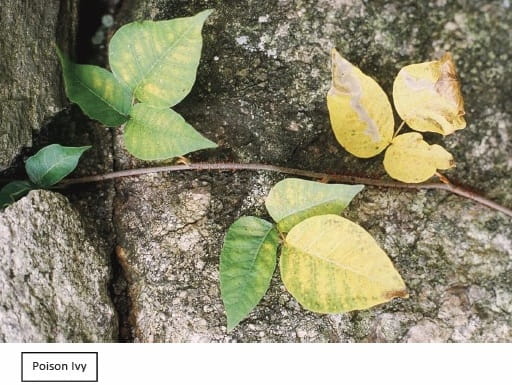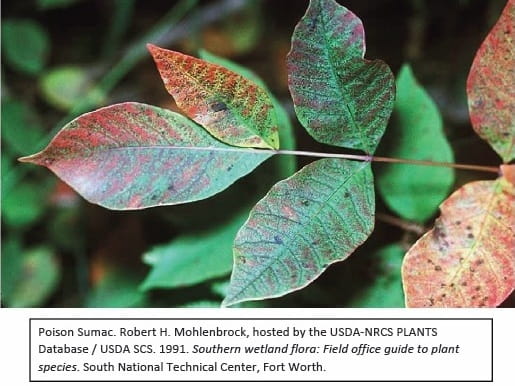Poison Ivy, Poison Oak and Poison Sumac Prevention and Treatment

The Bottom Line
Poison ivy, poison oak, and poison sumac can cause rashes if someone touches them. The rash is caused by oils in the plants. It may be severe enough to blister and itch for days or weeks. Most cases can be managed at home with household and OTC products. Severe cases require medical attention. If these plants are burned, inhaling the smoke can cause severe breathing problems.

The Full Story
Poison ivy, poison oak, and poison sumac can cause a severe rash if touched. The rash may blister and itch for days or weeks. These plants are widely distributed and very common in the continental United States. Poison ivy and poison sumac are typically encountered in the Midwest and Eastern states, and poison oak in the Western states.[1]
Most people will develop an itchy rash after coming into contact with poison ivy, poison oak, and poison sumac. This usually happens while working outside or during outdoor activities such as gardening, hiking, and camping. The rash is caused by an oil called urushiol (pronounced "you-ROO-shee-all"), which is found in every part of the plant, especially the leaves and stems.
The itchy rash, which can develop into painful blisters, often does not start until 1-2 days after coming into contact with the plant. In some cases, the itchy rash may take up to a week to appear. The rash typically lasts for 1-2 weeks. The rash itself is not contagious; it does not spread from one person to another. However, any oil left on the skin or clothes can get onto other parts of the body and cause another rash.
Recognizing poison ivy, oak, and sumac. Poison ivy, oak, and sumac can be tricky to identify. But, learning how to identify them is the most important step in avoiding them. Photos are helpful, but having someone point out the types that grow in your area might be the fastest way to learn!
Poison ivy vines usually have solid green and pointed leaves that hang from the stem in groups of three. (Remember: "leaves of three, let them be".) Poison ivy can grow as both a vine or as a shrub, and in most parts of the United States it typically grows as a vine. Be aware that as the seasons change, the poison ivy vine will often produce yellow-green flowers and white or off-white berries in the spring and early fall. During the autumn season, the typically green leaves can change to yellow and red as well.
Poison oak leaves look similar. Poison sumac leaves are arranged on each side of a branch. Poison oak and poison sumac are more like shrubs than vines.
Even when dried-up or "dead", the leaves and stems can cause a rash. These parts of the plant should never be handled nor used as kindling or fire-starting material. Burning the dead leaves and stems can release urushiol in the plant into the smoke. Inhaling this smoke can cause very severe breathing problems and lead to a trip to the emergency room.
Avoiding contact with poison ivy, oak, and sumac. The most effective way to prevent a rash is to avoid contact with the plant. That may not be realistic if you work outdoors or enjoy outdoor activities. There are some other ways to help prevent coming into contact with poison ivy:
- Wear closed-toed shoes, long sleeves, and long pants when outdoors. This helps to limit the amount of bare skin that could potentially come into contact with the poison ivy plant.
- Apply an OTC 'barrier' product such as Ivy-X® or Ivy Block® to your skin before you go outdoors. These products are creams or lotions that help to create a protective barrier between your skin and the oil from the poison ivy plant, as well as helping to prevent the oil from sticking to your skin.
Treating exposure to poison ivy, poison oak, and poison sumac. If you are exposed to poison ivy, poison oak, or poison sumac, rinse your skin with lukewarm, soapy water as soon as possible. The sooner you rinse, the more likely you are to remove the oil before it’s absorbed into your skin. If not washed off, the oil can spread from person to person and to other areas of your body.
There are some specialized cleansers sold as 'poison ivy soaps' (Tecnu®, among others) that may be more effective in removing the sticky oil from your skin, however common hand dish washing liquids may be just as effective.
Next, thoroughly wash (separately) all of the clothes you were wearing when you came into contact with the plant, along with any objects (tools, backpacks, golf clubs, etc.) and any pets that may have been exposed as well. The oil can stick to clothing and objects, and can cause another rash if it comes into contact again with your skin.
Treating a rash from poison ivy, poison oak, and poison sumac:
- If a rash occurs, avoid scratching, as scratching can cause an infection.
- If blisters form, leave them alone. Do not remove the loose skin from open blisters, as the skin can protect the wound underneath and help to prevent infection.
- Short, lukewarm baths or cool showers can help with itching. Avoid hot baths and showers, as they may worsen the itch.
- Topical products such as colloidal oatmeal baths (Aveeno®), calamine lotion, or hydrocortisone cream can help reduce itching from a poison ivy rash.
- Cool compresses made from a wet wash cloth and applied directly to the itchy rash may help.
- Antihistamine tablets such as diphenhydramine (Benadryl®) or cetirizine (Zyrtec®) can help to reduce itching. Use with caution because these product make some people sleepy.
- Do not apply an antihistamine cream or lotion to your skin, this may actually worsen the rash.
- See your doctor if the rash covers a large area, or if you can't control the itching.
[1] The scientific name for poison ivy is Toxicodendron radicans. Poison oak is Toxicodendron diversilobum [Pacific poison oak] and Toxicodendron pubescens [Atlantic poison oak]. Poison sumac is Toxicodendron vernix.
Robert Porter, PharmD, MPH
Certified Specialist in Poison Information
Poisoned?
Call 1-800-222-1222 or
Prevention Tips
- Learn to identify and avoid poison ivy/sumac/oak plants. Remember: "leaves of three, let them be".
- Remove these plants from yards and other areas where children might contact them.
- When hiking or camping outdoors, wear closed-toed shoes and long pants and sleeves to reduce exposure to bare skin.
- When possible, consider using an OTC barrier cream (e.g. Ivy-X®, Ivy Block®) before possible contact with poison ivy.
This Really Happened
A woman was exposed to poison ivy while gardening and pulling up weeds at her father's home. She was wearing gloves but her arms and legs were bare. Three days later, she developed an itchy rash on her arms. By the fifth day, the rash worsened. Fluid-filled blisters developed.
She tried to treat the painful, itchy rash at home with Caladryl® lotion (a topical anti-itch lotion that contains both calamine and diphenhydramine, the active ingredient in Benadryl®), Tecnu® washes (a soap designed specifically to help remove the oily poison ivy allergen from the skin), and ice.
Twelve days after the exposure, she called Poison Control for advice. She was advised to seek medical evaluation because her rash was severe and the products she was using didn't help. She was advised to discontinue the over-the-counter lotions and washes she was using without success. (In addition, Poison Control told her how to clean the contaminated clothing she used while weeding.)
The patient was evaluated at an urgent care clinic the following day and prescribed a course of oral steroids. The steroids helped to reduce the itching and her rash improved a few days later.
For More Information
For more information, including tips on how to identify and prevent poison ivy exposures, visit:
- American Academy of Dermatology. Poison Ivy: Tips for Treating and Preventing (2014) [Accessed 2014 Oct 12]
- Centers for Disease Control (CDC)/National Institute for Occupational Health and Safety (NIOSH). Poisonous Plants. (2014 July 21) [Accessed 2014 Oct 12]
- Mayo Clinic. Poison Ivy Rash. (2012 Aug 29) [Accessed 2014 Oct 12]
References
Boelman DJ. Emergency: treating poison ivy, oak, and sumac. Am J Nursing. 2010; 110(6):49-52.
Poisoned?
Call 1-800-222-1222 or
Prevention Tips
- Learn to identify and avoid poison ivy/sumac/oak plants. Remember: "leaves of three, let them be".
- Remove these plants from yards and other areas where children might contact them.
- When hiking or camping outdoors, wear closed-toed shoes and long pants and sleeves to reduce exposure to bare skin.
- When possible, consider using an OTC barrier cream (e.g. Ivy-X®, Ivy Block®) before possible contact with poison ivy.
This Really Happened
A woman was exposed to poison ivy while gardening and pulling up weeds at her father's home. She was wearing gloves but her arms and legs were bare. Three days later, she developed an itchy rash on her arms. By the fifth day, the rash worsened. Fluid-filled blisters developed.
She tried to treat the painful, itchy rash at home with Caladryl® lotion (a topical anti-itch lotion that contains both calamine and diphenhydramine, the active ingredient in Benadryl®), Tecnu® washes (a soap designed specifically to help remove the oily poison ivy allergen from the skin), and ice.
Twelve days after the exposure, she called Poison Control for advice. She was advised to seek medical evaluation because her rash was severe and the products she was using didn't help. She was advised to discontinue the over-the-counter lotions and washes she was using without success. (In addition, Poison Control told her how to clean the contaminated clothing she used while weeding.)
The patient was evaluated at an urgent care clinic the following day and prescribed a course of oral steroids. The steroids helped to reduce the itching and her rash improved a few days later.
